Roebuck
Roebuck is an exemplary work by Gustave Courbet, a defining artist of the 19th-century Realism movement. Known for his authentic representations of life and nature, this painting showcases Courbet's masterful technique and deep connection with his subjects. Roebucks, often symbols of grace and wild beauty, are encapsulated through Courbet's unique vision, making this piece a significant contribution to the art world. The painting can be acquired in various formats, enhancing its appeal to art lovers and collectors alike.
Mid 19th Century
About the Artwork
Roebuck represents one of the quiet yet powerful statements Courbet was known for throughout his career as a realist painter. He often painted subjects drawn from nature, imbued with his unflinching dedication to portraying life as he saw it. While specific details about its history are sparse, the painting reflects Courbet's ethos of engaging with the real world, transforming mundane subjects into significant works of art. Throughout his life, Courbet fought against the established art norms of his time, advocating for a more truthful depiction of society, nature, and experience. Thus, Roebuck can be seen as a parallel to his broader mission, lending insight into the beauty and complexities of the world around us, championing the idea that nature, in all its forms, deserves representation in art.
Did You Know
Liked what you see? Add it to your collection.
Enjoyed reading? Share it.
... continued
Artist
Gustave Courbet was a French painter known for his innovative and bold social statements through his art. He was committed to painting only what he could see, adhering strictly to the principles of realism.
Artwork
Roebuck is one of Courbet's works, although specific details about the painting itself, such as its date of creation or the context in which it was painted, are not readily available in the sources provided. The painting is available for purchase as various forms of wall art, home decor, and other items through several online platforms.










